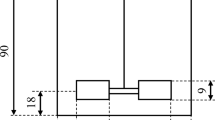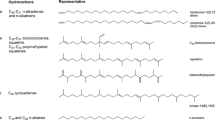Abstract
Some of the key reasons for why the production of biofuels from microalgae have not yet succeeded as a source of sustainable transport fuel are the costs involved and the amount of energy needed to obtain the oils compared to the energy contained in the final fuel. The key energy costs are in the dewatering of biomass followed by extraction of the oil, disposal of biomass, and the energy content of the nutrient fertiliser needed for regrowing the algae. In this study, we bypass all of these barriers by using a different approach towards cutting energy and fertiliser costs in the production of biofuels from microalgae—rather than growing the algae in the presence of fertilisers such as N and P, followed by harvesting the whole algae cells, and the energetically costly drying of cells and extraction of the fuel from the cells, this process makes use of the natural tendency of the green alga, Botryococcus braunii to release oils from the cell into the extracellular matrix during and after growth. Here, we non-destructively and repeatedly harvest the external oil (hydrocarbons) from B. braunii CCAP 807/2. Extraction with several solvents showed that hexane was not compatible with B. braunii, but that heptane in contact with B. braunii for less than 20 min did not negatively affect this alga. As an alternative, solvent-free method, we tested physical methods of extracting the extracellular oil. Light and temperature did not affect the extraction of the external oil from Botryococcus, but gentle pressure (i.e. ‘blotting’) was an effective method for external oil recovery. Less than 1 h of blotting also did not affect the physiology of Botryococcus. Both the heptane extraction and the non-destructive ‘blotting’ methods had no significant effect on growth and photosynthesis (F v/F m, ETRmax) of B. braunii. Our results indicate that over a period of 6 days, we can repeatedly extract over 35 % (using heptane) and 1 % (using ‘blotting’) of the total oil, mainly in the form of external hydrocarbon in stationary phase cells without damage to the cells.





Similar content being viewed by others
References
Ackman RG (1991) Application of thin-layer chromatography separation: neutral lipids. In: Perkins EG (ed) Analyses of fats, oils and lipoproteins. American Oil Chemists Society, Champaign, Illinois, pp 60–82
An JY, Sim S-J, Kim BW, Lee JS (2004) Improvement of hydrocarbon recovery by two-stage cell-recycle extraction in the cultivation of Botryococcus braunii. J Microbiol Biotech 14:932–937
Blackburn KB (1936) Botryococcus and the algal coals. Part I: a reinvesigation of the alga Botryococcus braunii Kutzing. Trans R Soc Edinburgh 58:841–854
Borowitzka MA, Moheimani NR (2013) Sustainable biofuels from algae. Mitig Adapt Strat Glob Change 18:13–25
Cane RF, Albion PR (1973) The organic geochemistry of torbanite precursors. Geochim Cosmochim Acta 37:1543–1549
Carpenter JH (1966) New measurements of oxygen solubility in pure and natural water. Limnol Oceanogr 11:264–277
Cordell D, Drangert JO, White S (2009) The story of phosphorus: global food security and food for thought. Glob Environ Chang 19:292–305
Dayananda C, Sarada R, Srinivas P, Shamala T, Ravishankar G (2006) Presence of methyl branched fatty acids and saturated hydrocarbons in botryococcene producing strain of Botryococcus braunii. Acta Physiol Plant 28:251–256
de Boer K, Moheimani N, Borowitzka M, Bahri P (2012) Extraction and conversion pathways for microalgae to biodiesel: a review focused on energy consumption. J Appl Phycol 24:1681–1698
Eroglu E, Melis A (2010) Extracellular terpenoid hydrocarbon extraction and quantitation from the green microalgae Botryococcus braunii var. Showa. Biores Technol 101:2359–2366
Fon Sing S, Isdepsky A, Borowitzka MA, Moheimani NR (2013) Production of biofuels from microalgae. Mitig Adapt Strat Glob Change 18:47–72
Frenz J, Largeau C, Casadevall E (1989) Hydrocarbon recovery by extraction with a biocompatible solvent from free and immobilized cultures of Botryococcus braunii. Enzym Microb Technol 11:717–724
Fried B, Sherma J (1982) Thin-layer chromatography: techniques and applications. Marcel Dekker, New York, pp 105–122
Hejazi MA, Holwerda E, Wijffels RH (2004) Milking microalga Dunaliella salina for β-carotene production in two-phase bioreactors. Biotech Bioeng 85:475–481
Kanazawa Z, Fujita C, Yuhara T, Sasa T (1958) Mass culture of unicellular algae using the "open pond circulation method". J Gen Appl Microbiol 4:135–139
Kates M, Volcani BE (1966) Lipid components of diatoms. Biochim Biophys Acta 116:264–278
Kirk JTO (1994) Light and Photosynthesis in Aquatic Ecosystems. Cambridge University Press, Cambridge
Kleinegris D, van Es M, Janssen M, Brandenburg W, Wijffels R (2011) Phase toxicity of dodecane on the microalga Dunaliella salina. J Appl Phycol 23:949–958
Lundquist TJ, Woertz IC, Quinn NWT, Benemann JR (2010) A realistic technology and engineering assessment of algae biofuel production. California Polytechnic State University, San Luis Obispo, p 178
Largeau C, Casadevall E, Berkaloff C, Dhamelincourt P (1980) Sites of accumulation and composition of hydrocarbons in Botryococcus braunii. Phytochemistry 19:1043–1051
Mercz TI (1994) A study of high lipid yielding microalgae with potential for large-scale production of lipids and polyunsaturated fatty acids. PhD Thesis. Murdoch University, Perth, p 278
Metzger P, Largeau C (2005) Botryococcus braunii: a rich source for hydrocarbons and related ether lipids. Appl Microbiol Biotech 66:486–496
Moheimani NR (2013) Long term outdoor growth and lipid productivity of Tetraselmis suecica, Dunaliella tertiolecta, and Chlorella sp (Chlorophyta) in bag photobioreactors. J Appl Phycol 25:167–176
Moheimani N, Borowitzka M (2006) The long-term culture of the coccolithophore Pleurochrysis carterae (Haptophyta) in outdoor raceway ponds. J Appl Phycol 18:703–712
Moheimani NR, Borowitzka MA (2007) Limits to productivity of the alga Pleurochrysis carterae (Haptophyta) grown in outdoor raceway ponds. Biotech Bioeng 96:27–36
Moheimani NR, Lewis D, Borowitzka MA, Pahl S (2011) Harvesting, thickening and dewatering microalgae. In: Carioca JOB (ed) International Microalgae and Biofuels Workshop. CENER, Fortaleza, pp 267–277
Moheimani NR, Isdepsky A, Fon Sing S, Borowitzka MA (2013) Standard methods for measuring growth of algae and their composition. In: Borowitzka MA, Moheimani NR (eds) Algae for biofuels and energy. Springer, Dordrecht, pp 265–285
Platt T, Gallegos CL, Harrison WG (1980) Photoinhibition of photosynthesis in natural assemblages of marine phytoplanton. J Mar Res 38:687–701
Ralph PJ, Gademann R (2005) Rapid light curves: A powerful tool to assess photosynthetic activity. Aquat Bot 82:222–237
Ratledge C, Kristiansen B (2001) Basic Biotechnology. Cambridge University Press, Cambridge
Redfield AC (1958) The biological control of chemical factors in the environment. Am Sci 46:230A–221
Sauer T, Galinski EA (1998) Bacterial milking: a novel bioprocess for production of compatible solutes. Biotech Bioeng 57:306–313
Sheehan J, Dunahay T, Benemann J, Roessler P (1998) A look back at the U.S. department of energy's aquatic species program-biodiesel from algae. NREL Report No. TP-580-24190. 325 pp
Sim SJ, An JY, Kim BW (2001) Two-phase extraction culture of Botryococcus braunii producing long-chain unsaturated hydrocarbons. Biotech Lett 23:201–205
Sim S, Chang H (1993) Increased shikonin production by hairy roots of Lithospermum erythrorhizon in two phase bubble column reactor. Biotech Lett 15:145–150
Stumm W, Morgan JJ (1996) Aquatic chemistry: chemical equilibria and rates in natural waters. John Wiley & Sons, NewYork, 1022 pp
Wake L, Hillen L (1981) Nature and hydrocarbon content of blooms of the alga Botryococcus braunii occurring in Australian freshwater lakes. Aust J Mar Freshwat Res 32:353–367
Zittelli G, Zittelli GC, Rodolfi L, Tredici MR (2003) Mass cultivation of Nannochloropsis sp. in annular reactors. J Appl Phycol 15:107–114
Acknowledgments
This study was funded by the Murdoch University Strategic Research Fund. The authors would like to thank Azadeh Mohammadbagheri, Emily Quek and Celia Smuts for their excellent technical assistance.
Author information
Authors and Affiliations
Corresponding author
Rights and permissions
About this article
Cite this article
Moheimani, N.R., Cord-Ruwisch, R., Raes, E. et al. Non-destructive oil extraction from Botryococcus braunii (Chlorophyta). J Appl Phycol 25, 1653–1661 (2013). https://doi.org/10.1007/s10811-013-0012-9
Received:
Revised:
Accepted:
Published:
Issue Date:
DOI: https://doi.org/10.1007/s10811-013-0012-9




